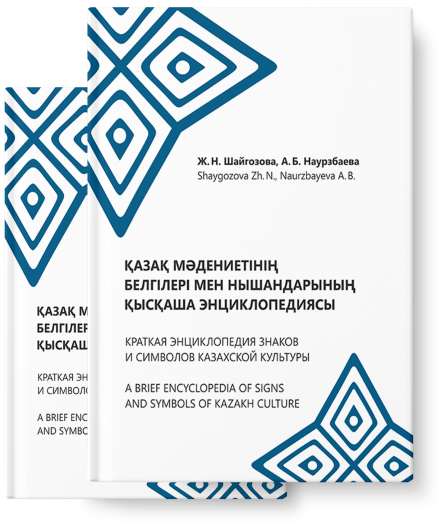
A short encyclopedia of
Signs and symbols of
Kazakh culture

The name is one of the most important symbols of power in Turkic-Mongolian culture. An illustrative example is the title name of Chingizkhan, which, according to N.Z. Mynbayev, consists of two components: shyn – “unattainable height” and qas “true, fierce”, i.e. Shyn+qas+khan means: “true”, “sublime”, fierce Khan” [2]. From the point of view of semiotics, a proper name is a sign that has a certain value [3, p. 115]. The name “stores” the hidden content of discursive information, is a hypermark, and can be interpreted as a myth.
According to A. V. Superanskaya [4], in the Turkic-Mongol environment, sons were traditionally given the names of sworn enemies, so that the power and greatness of the slain enemies passed to the recruited. According to L.N. Gumilev, Turks did not bear the same name as Europeans from birth to death. The name of the Turk always indicated his position in society. As a boy he had a nickname, young men – rank, husband – title, and if it was a khan, then the title changed according to the specific and rank system” [5, p. 90].
This is confirmed by numerous written monuments, which usually contain the self-representation “Er atym…” (my hero/male name…). Similar words – demonstration of the high social status of the man in the ancient Turkic society, protector of the family, tribe, haganate, homeland. The honorary title of the man-warrior ( er ), which the youth received only after the initiation rite: the performance of a hunt or a military feat.
This tradition is evident among Kazakhs, for example, Sabalak (juvenile name) – Abulmansur (proper name) – Ablai khan (name title). The latter was given to Abulmansur after his official appointment as Khan, who had previously defeated the Dzungar Sharysh. A bright and specific name sign appears in Hakknazar khan, who was popularly called Alasha khan. The researches of the well-known Kazakh historian I.V. Yerofeyeva show that he was probably one of the first Kazakh khans who introduced wearing striped robes. These robes were made of a colorful silk fabric called patshai (royal cloth).The striped robe was handmade, of course. They were unique items reserved only for Bukhara Khans and their relatives, officials and foreign honoured guests” [6]. Hence the original name and title Alasha Khan. The historical role of Khakknazar Khan in the formation of the Kazakh state can hardly be overestimated. He is credited with expanding the borders of the Kazakh Khanate and uniting various tribes into one people. Probably because of this, the term “Alasha” was later used as a synonym and battle cry for Kazakhs, and Alasha khan himself is considered a mythologized ancestor of the Kazakhs.

